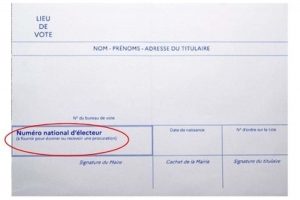For the first time, a QR code is included on the electoral card that will be sent to all registered voters for the presidential and legislative elections.
This QR code refers to the single site allowing you to access all the procedures related to the elections. In a few clicks, you can
- check your electoral situation ;
- find your polling station;
- register online, until March 2, 2022, on the electoral lists;
- apply for a proxy if you are absent on election day. You can also check to whom you have given proxy or who has given you proxy.
The www.elections.interieur.gouv.fr website also provides access to content to help you understand the role and democratic purpose of voting, the different types of elections organized in France, the competence of elected officials, etc.


In addition, your national voter number, assigned to each voter, has been highlighted. This number is now necessary to establish a proxy.
This permanent number, unique and specific to each voter, is composed of 8 or 9 digits in most cases. This number makes it possible to identify in a certain way a voter among the 48 million registered on the electoral lists. It appears on the electoral card and can also be found by querying your electoral situation online at: https://www.elections.interieur.gouv.fr/toutes-mesdemarches-electorales/je-verifiema-situation-electorale
NOTE: Since January 1, 2022, proxies are deterritorialized. This means that you, the principal, can give proxy to a voter, the agent, who is not registered in the same municipality as you. The proxy will still have to go to your polling station on election day to vote in your place.
When filling out the proxy application, you must enter your national voter number and that of your proxy.
What is the purpose of an electoral card ?
The electoral card – also called the voter’s card – is a document proving your registration on the electoral roll of your municipality. It is sent to new voters the year following their registration or, in case of election, the year of their registration.
The electoral card contains the following information
- Name of the voter
- First names of the voter
- Address of domicile or residence
- Date of birth of the voter
- National Voter Number
- Voter’s polling place
- QR codeOn election day, you can go to the polling station with your voter registration card. This facilitates the work of the polling station officials. However, you are not required to show your voter registration card to vote.
How do I register to vote?
To be able to vote in the next elections, it is necessary to register on the electoral roll of your municipality. It is possible to register until the sixth Friday before the election, i.e. March 4, 2022 for the presidential election, either by mail or directly at the town hall. You can also register online until the sixth Wednesday before the election, i.e. Wednesday, March 2, 2022 for the presidential election.
Register in a few clicks on: https://www.elections.interieur.gouv.fr/toutes-mesdemarcheselectorales/je-minscris-sur-listes-electorale
Where can I get my electoral card ?
To get your new electoral card, you don’t have to do anything if you are registered on the electoral lists. It will be sent to your home by your town hall.
This mailing is the result of the revision of the electoral lists carried out by the town halls every 5 years. This is a material operation which allows to order the electoral lists by assigning an order number to each voter and which allows to facilitate the work of the assessors on the day of the election.
In fact, it is a reorganization of the lists, with reclassification of the voters in alphabetical order and attribution of a new number following this order. This recasting also integrates the changes in the perimeter of the polling stations that have occurred since the previous recasting. Each polling station is assigned to a geographical area. The municipality assigns its voters to the polling stations according to their home address. To ensure the smooth running of the electoral process, a polling station generally does not exceed 800 to 1,000 voters.
The last reorganization took place exceptionally in 2019 at the time of the implementation of the Single Electoral Register and the appearance of new fields on the electoral map. It is normally customary to carry out this recast of the electoral lists prior to the presidential election; the two previous ones had taken place before the 2012 and 2017 presidential elections.
Since the last redesign in 2019, 5.2 million new registrations or re-registrations have taken place.

